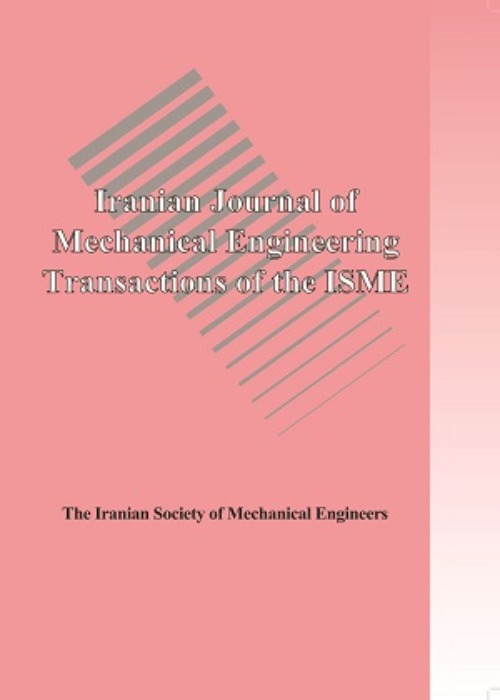فهرست مطالب
Iranian Journal of Mechanical Engineering Transactions of ISME
Volume:12 Issue: 1, Mar 2011
- تاریخ انتشار: 1391/07/08
- تعداد عناوین: 6
-
-
Instruction for the Preparation of Camera-Ready PapersPage 1
-
Page 5In this article, the multi-objective optimization of cylindrical aluminum tubes under axial impact load is presented. The absorbed energy and the specific absorbed energy (SEA) are considered as objective functions while the maximum crush load should not exceed allowable limit. The geometric dimensions of tubes including diameter, length and thickness are chosen as design variables. The Non-dominated Sorting Genetic Algorithm –II (NSGAII) is applied to obtain the Pareto optimal solutions. A back-propagation neural network is constructed as the surrogate model to formulate the mapping between the design variables and the objective functions. The finite element software ABAQUS/Explicit is used to generate the training and test sets for the artificial neural networks. To validate the results of finite element model, several impact tests are carried out using drop hammer.Keywords: Cylindrical tube, Energy absorption, Neural networks, Multi, objective optimization
-
Page 19In this paper, a modified two-fluid model has been adopted to simulate the process of upward vertical subcooled flow boiling of refrigerant R-113 in a vertical annular channel at low pressure. The modified model considers temperature dependent properties and saturation temperature variation and was validated against a number of published low-pressure subcooled boiling experiments. The results show good agreement with experimental data including radial profiles of void fraction, phase velocities and liquid temperature. A sinusoidal axial distribution of wall heat flux was applied as well as constant wall heat flux. Results show that by increasing the wall heat flux, the bubble boundary layer will become thicker and the profiles of axial liquid velocity will gradually depart from those of singlephase flow.Keywords: Two, fluid model, Refrigerant, 113, Saturation temperature variation, Subcooled boiling flow
-
Page 41This study deals with the elastic-plastic impact on moderately thick rectangular plate subjected to uniform in-plane compressive loads resting on the Pasternak elastic foundation. The proposed rectangular plates have two opposite edges simply-supported, while all possible combinations of free, simply-supported and clamped boundary conditions are applied to the other two edges. The dimensionless equations of motion of the plate are obtained by applying the Reissner-Mindlin plate theory considering the first-order shear deformation and the rotary inertia effects. The exact closed form solution of the governing equations leading to more accurate result with less calculating time in comparison with the Rayleigh-Ritz method is used to obtain the dynamic response of the plat. The validity of the result is first examined by studying the convergence of the maximum impact force. Then, a comparison of results with those available in literature confirms the excellent accuracy of the present approach. Finally the effects of the dimensionless parameters such as uniaxial and biaxial in-plane loads and the effect of foundation stiffness parameters on force and displacement histories have been examined.Keywords: Low velocity impact, first order shear deformation theory, permanent indentation, in, plane loads, elastic foundation
-
Page 68To study the feasibility of using two edible plant oils as diesel substitute a comparative study was made. Oils were exacted from the seeds of soyabean (Glycine Max, Family: Leguminoceae) and sunflower (Helianthus annuus, Family: Asteraceae/Compositeae). Oils were esterified (butyl esters) before blending with pure diesel in the ratio of 10:90, 15:85, 20:80, and 25:75 by volume. Pure diesel was used as control. Studies have revealed that on blending vegetable oils with diesel a remarkable improvement in their physical and chemical properities took place. Cetane number came to be very close to pure diesel. Engine (C.I.) was run at different loads (0, 4, 8, 12, 16, and 20 kg) at a constant speed (1500 rpm) separately on each blend and also on pure diesel. Studies have revealed that soyabean oil at 20% blend with diesel gave best performance in terms of low smoke intensity, emission of HC and NOx. All the parameters tested viz., flash point, total fuel consumption, specific energy consumption, specific fuel consumption, brake thermal efficiency and cylindrical peak pressure were improved. Results have further indicated that at 20% blend engine showed a closer performance to pure diesel. 20% blend of soyabean oil exhibited better performance than sunflower oil blends. However, both the oils at 20% blends with diesel can be used as a diesel substitute. There studies have thus indicated that esterified soyabean oil at 20% blend satisfies the important fuel properties as per ASTM D975 specifications of biodiesel as it lead to the improvement of engine performance and emission characteristics without any modification in engine.Keywords: Vegetable oil, Biodiesel, Transesterification, Performance analysis, Butyl ester soyabean oil, Butyl ester sunflower oil, Combustion characteristics
-
Page 86In this paper the Quasi-Static poro-thermoelasticity model of a hollow and solid sphere under radial symmetric loading condition (r, t) is‡ considered. A full analytical method is used and an exact unique solution of the Quasi-Static equations is presented. The thermal, mechanical and pressure boundary conditions, the body force, the heat source and the injected volume rate per unit volume of a distribute water source are considered in the most general forms where no limiting assumption is used. This generality allows to simulate variety of applicable problems.Keywords: Quasi, Static Poro, Thermoelasticity, Hollow sphere, Exact solution


